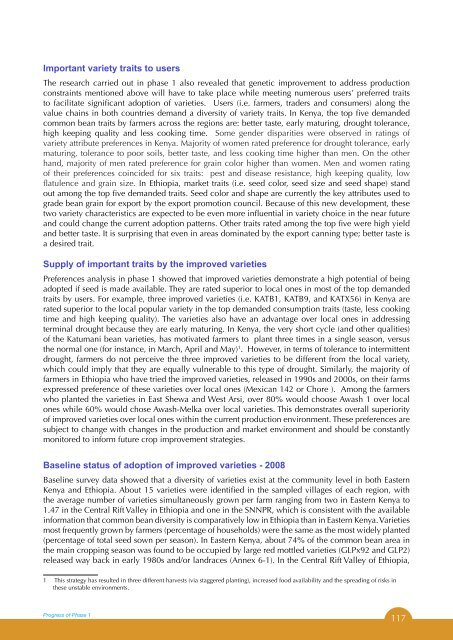Final version of Tropical Legumes II Project Report for Phase 1 - icrisat
Final version of Tropical Legumes II Project Report for Phase 1 - icrisat
Final version of Tropical Legumes II Project Report for Phase 1 - icrisat
Create successful ePaper yourself
Turn your PDF publications into a flip-book with our unique Google optimized e-Paper software.
Important variety traits to users<br />
The research carried out in phase 1 also revealed that genetic improvement to address production<br />
constraints mentioned above will have to take place while meeting numerous users’ preferred traits<br />
to facilitate significant adoption <strong>of</strong> varieties. Users (i.e. farmers, traders and consumers) along the<br />
value chains in both countries demand a diversity <strong>of</strong> variety traits. In Kenya, the top five demanded<br />
common bean traits by farmers across the regions are: better taste, early maturing, drought tolerance,<br />
high keeping quality and less cooking time. Some gender disparities were observed in ratings <strong>of</strong><br />
variety attribute preferences in Kenya. Majority <strong>of</strong> women rated preference <strong>for</strong> drought tolerance, early<br />
maturing, tolerance to poor soils, better taste, and less cooking time higher than men. On the other<br />
hand, majority <strong>of</strong> men rated preference <strong>for</strong> grain color higher than women. Men and women rating<br />
<strong>of</strong> their preferences coincided <strong>for</strong> six traits: pest and disease resistance, high keeping quality, low<br />
flatulence and grain size. In Ethiopia, market traits (i.e. seed color, seed size and seed shape) stand<br />
out among the top five demanded traits. Seed color and shape are currently the key attributes used to<br />
grade bean grain <strong>for</strong> export by the export promotion council. Because <strong>of</strong> this new development, these<br />
two variety characteristics are expected to be even more influential in variety choice in the near future<br />
and could change the current adoption patterns. Other traits rated among the top five were high yield<br />
and better taste. It is surprising that even in areas dominated by the export canning type; better taste is<br />
a desired trait.<br />
Supply <strong>of</strong> important traits by the improved varieties<br />
Preferences analysis in phase 1 showed that improved varieties demonstrate a high potential <strong>of</strong> being<br />
adopted if seed is made available. They are rated superior to local ones in most <strong>of</strong> the top demanded<br />
traits by users. For example, three improved varieties (i.e. KATB1, KATB9, and KATX56) in Kenya are<br />
rated superior to the local popular variety in the top demanded consumption traits (taste, less cooking<br />
time and high keeping quality). The varieties also have an advantage over local ones in addressing<br />
terminal drought because they are early maturing. In Kenya, the very short cycle (and other qualities)<br />
<strong>of</strong> the Katumani bean varieties, has motivated farmers to plant three times in a single season, versus<br />
the normal one (<strong>for</strong> instance, in March, April and May) 1 . However, in terms <strong>of</strong> tolerance to intermittent<br />
drought, farmers do not perceive the three improved varieties to be different from the local variety,<br />
which could imply that they are equally vulnerable to this type <strong>of</strong> drought. Similarly, the majority <strong>of</strong><br />
farmers in Ethiopia who have tried the improved varieties, released in 1990s and 2000s, on their farms<br />
expressed preference <strong>of</strong> these varieties over local ones (Mexican 142 or Chore ). Among the farmers<br />
who planted the varieties in East Shewa and West Arsi, over 80% would choose Awash 1 over local<br />
ones while 60% would chose Awash-Melka over local varieties. This demonstrates overall superiority<br />
<strong>of</strong> improved varieties over local ones within the current production environment. These preferences are<br />
subject to change with changes in the production and market environment and should be constantly<br />
monitored to in<strong>for</strong>m future crop improvement strategies.<br />
Baseline status <strong>of</strong> adoption <strong>of</strong> improved varieties - 2008<br />
Baseline survey data showed that a diversity <strong>of</strong> varieties exist at the community level in both Eastern<br />
Kenya and Ethiopia. About 15 varieties were identified in the sampled villages <strong>of</strong> each region, with<br />
the average number <strong>of</strong> varieties simultaneously grown per farm ranging from two in Eastern Kenya to<br />
1.47 in the Central Rift Valley in Ethiopia and one in the SNNPR, which is consistent with the available<br />
in<strong>for</strong>mation that common bean diversity is comparatively low in Ethiopia than in Eastern Kenya. Varieties<br />
most frequently grown by farmers (percentage <strong>of</strong> households) were the same as the most widely planted<br />
(percentage <strong>of</strong> total seed sown per season). In Eastern Kenya, about 74% <strong>of</strong> the common bean area in<br />
the main cropping season was found to be occupied by large red mottled varieties (GLPx92 and GLP2)<br />
released way back in early 1980s and/or landraces (Annex 6-1). In the Central Rift Valley <strong>of</strong> Ethiopia,<br />
1 This strategy has resulted in three different harvests (via staggered planting), increased food availability and the spreading <strong>of</strong> risks in<br />
these unstable environments.<br />
Progress <strong>of</strong> <strong>Phase</strong> 1<br />
117
















